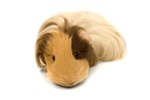
If your guinea pig experiences any eye issues, take him to the vet immediately for treatment and diagnosis. Cataracts are fairly common in older guinea pigs. In a British study of ocular disease in the guinea pig, 1,000 animals were surveyed. Of these, 17 percent had cataracts, while 45 percent had some sort of eye abnormality.
Eye Appearance
Your guinea pig's eyes should appear clear, bright and shiny. If you notice a milkiness in the lens of your pet's eye, suspect a cataract. As the lens clouds, the ability to see decreases. There's no way to prevent cataract development, but keeping the cage clean and free of sharp objects helps prevent other guinea pig eye issues, such as corneal ulcers due to injury.
Causes
Just as in people, cataracts primarily affect senior guinea pigs. They could also result from diabetes, so your vet will take a blood sample and check your pet's sugar levels. Some cataracts are hereditary, so genetically prone guinea pigs develop them at a young age. If your guinea pig develops cataracts while young, avoid breeding him. Cataracts can't be cured in guinea pigs, so your pet will eventually lose his vision. However, eyesight isn't the strongest of the cavy's senses, and he'll probably function quite well with limited or no vision.
Prevalence
In guinea pigs, it's quite common for cataracts to appear in both eyes. In the British study, nearly 75 percent of guinea pigs with congenital cataracts -- those present at birth -- had them in both eyes, while 68 percent of the cavies developing cataracts in old age had both eyes affected. Fifty-four percent of those diagnosed with diabetic cataracts had them in each eye.
Care
If your guinea pig is diagnosed with cataracts, it's likely he already has some degree of vision loss. You might not have noticed the cataract development until it was quite advanced, with little hint of eye disease from your pet's behavior. Care for your guinea pig in the normal way, avoiding changing the positions of his food dishes and water bottles within the cage. You might not want to add an unfamiliar guinea pig to the cage. The 1,000 animal study noted that the "welfare of animals blind with mature cataract did not appear overly compromised." Researchers found no difference in behavior among normally sighted guinea pigs and those with cataracts in areas such as food foraging, negotiating objects in familiar territory and interacting with known cage-mates.
References
Photo Credits
-
BananaStock/BananaStock/Getty Images
Writer Bio
Jane Meggitt has been a writer for more than 20 years. In addition to reporting for a major newspaper chain, she has been published in "Horse News," "Suburban Classic," "Hoof Beats," "Equine Journal" and other publications. She has a Bachelor of Arts in English from New York University and an Associate of Arts from the American Academy of Dramatics Arts, New York City.




